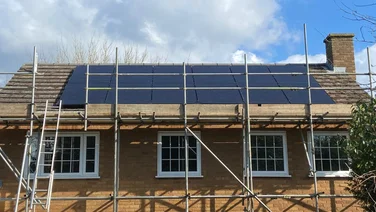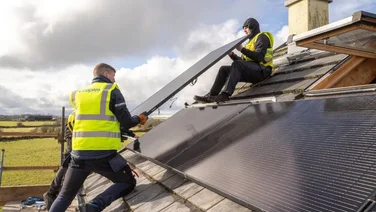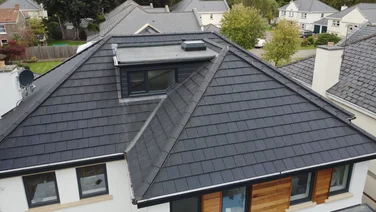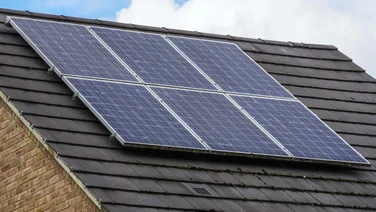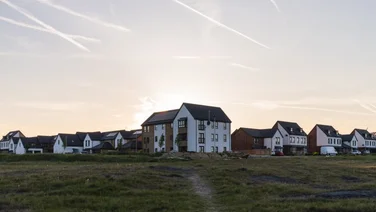- What is the Home Energy Scotland Grant and Loan?
- What does the Home Energy Scotland Grant and Loan cover?
- Who’s eligible for the Home Energy Scotland Grant and Loan?
- How long will the Home Energy Scotland Grant and Loan be available?
- Has the Home Energy Scotland Grant and Loan been a success?
- Summary
- You can apply for up to £38,500 of interest-free loans
- You won’t have to pay back up to £17,750 of this amount
- The loan can be paid back over 12 years, or not at all if you’re eligible for a grant
If you want to save money on your energy bills and fight climate change at the same time, we’ve got good news: there’s a government grants scheme enabling people to do exactly that.
Set up by Warmer Homes Scotland in 2017, the Home Energy Scotland Grant and Loan has helped thousands of households afford the upfront costs of solar panels and other renewable systems.
In this guide, we’ll tell you everything you need to know about this scheme, including how much you can borrow, how long you’ll have to pay it back, and which improvements it covers.
If the Home Energy Scotland Grant and Loan has made the prospect of buying solar panels even more attractive, you can fill in this form to receive free quotes from trusted suppliers.
Where do you want to install solar panels?
Get started
What is the Home Energy Scotland Grant and Loan?
The Home Energy Scotland Grant and Loan is a government scheme that offers grants of up to £7,500 and interest-free loans of up to £38,500 to homeowners wanting to make their households more energy efficient.
The scheme has proven particularly helpful during the recent energy crisis – especially since Scotland has seen some of the UK’s highest energy bills. Check out our page on Why Scotland Should Have Cheaper Electricity Than England to learn more.
How does the interest-free loan work?
You can apply for loans in two categories. Firstly, you can receive up to £15,000 to make energy-efficient improvements.
You can also get up to £17,500 for two renewable systems or connections to an approved renewable district heating system, plus as much as £6,000 for an energy storage system – which is also included in the renewable system category.
The loans can be paid back over as many as 12 years, and you may not have to pay back the full amount.
Up to 40% of the cost of your energy-efficient improvements or the entire loan for them – whichever is lower – may be provided through cashback funding.
This cashback offers as much as 75% when it comes to paying for your renewable system.
This is basically a reward for choosing a particularly eco-friendly measure, and turns part of your interest-free loan into a grant, with no strings attached.
There’s a limited amount of government money available for cashback funding, so make sure you apply while there’s still enough to go around. Cashback funding and loans are handed out on a first-come, first-served basis.
It’s also worth mentioning that there is an administrative fee of 1.5% – up to a maximum of £150 – on each successful loan application, but that seems like a small price to pay.
How does the grant work?
Homeowners can also get a grant through the scheme to help them install various energy efficiency improvements.
The grant can cover up to 75% of the combined cost of the improvements – up to the maximum grant amount of £7,500, or £9,000 if the household qualifies for the rural uplift.
However, the grant won’t cover the following installations:
- Replacement heat pumps
- Wind or hydro turbines
- Warm air units
- Solar water heating systems
- Double or secondary glazing
- Insulated doors
- Heat network connections
The government website highlights that solar PV systems, energy storage systems, biomass boilers/stoves, and high-heat-retention storage heaters might be eligible for grant funding ‘if certain conditions are met’.
Since June 2023, Home Energy Scotland Grant and Loan funding for solar panels in Scotland has only been available in a package that combines panels with a heat pump or storage heaters.
It’s also worth mentioning that the scheme isn’t available to anyone receiving grant support from another source for the same improvement, such as Area Based Schemes or ECO.
Want to check out what other grants are available in Scotland? Find out by visiting our page: Scottish Government Grants For Solar Panels.
How long do you have to repay the loan?
The length of the repayment period is up to you, to an extent.
You have up to 12 years to repay any loan above £10,000, with this repayment period shrinking to five or 10 years if you borrow less.
| Loan amount | Maximum repayment time |
|---|---|
Less than £5,000 | 5 years |
£5,000–£9,999 | 10 years |
More than £10,000 | 12 years |
What does the Home Energy Scotland Grant and Loan cover?
The Home Energy Scotland Grant and Loan covers a wide variety of energy-efficient improvements and renewable systems – and a few secondary improvements, too.
Here are all your options, along with the maximum loan and cashback funding you can get for them.
Energy-efficient improvements
You can apply for any of the following improvements, up to the maximum loan level of £15,000.
You may receive 40% of that loan as cashback, meaning you won’t have to pay it back – but as you can see below, it depends on which improvement you pick.
The grant is only available for some of the following home improvements – and the ones it is available for, can be supplemented with an additional loan if necessary.
| Improvement | Maximum loan | Maximum cashback | Maximum grant options |
|---|---|---|---|
| Solid wall insulation | £6,000 | £4,000 | £7,500, plus £2,500 optional loan |
| Gas heating system | £5,000 | None | No grant available |
| Gas connection | £5,000 | None | No grant available |
| Warm air unit or electric storage heaters | £4,600 | £400 | £2,500 when installed as part of a package of measures |
| Insulated doors | £4,500 | None | No grant available |
| Replacing single glazing with double glazing | £4,100 | £400 | No grant available |
| Flat roof or room-in-roof insulation | £2,400 | £1,600 | £3,000, plus £1,000 optional loan |
| Loft, floor, or cavity wall insulation | £600 | £400 | £1,500, plus £500 optional loan |
Secondary improvements
You can apply for another loan of up to £500 – including up to £200 in cashback funding or a grant of up to £375 – for secondary improvements.
These must be combined with a specific energy-efficient improvement listed above, and include heating controls, hot water jackets, and cylinder thermostats.
Renewable systems
You’re also allowed to apply for loans to pay for a maximum of two renewable systems, up to the £17,500 limit, and an energy storage system like a solar battery or thermal energy store, which comes with an extra loan of up to £6,000.
You may receive as much as £11,750 of these loans as cashback, depending on which systems you get installed.
And if its heat pumps or biomass boilers you’re after, you might be able to get a grant to help pay for the upfront costs.
69% of people are likely or very likely to buy or rent a property with solar panels, according to our latest National Home Energy Survey.
| Renewable system | Maximum loan | Maximum cashback | Maximum grant options |
|---|---|---|---|
| Hybrid PV-solar water & heating systems | £7,500 | None | No grant available |
| Heat pumps (air, ground, water, or hybrid) | £2,500 | £7,500 | £7,500, plus £7,500 optional loan – or £9,000, plus £7,500 optional loan, if the household qualifies for the rural uplift |
| Biomass boilers or stoves | £2,500 | £7,500 | £7,500 if there’s evidence that a heat pump is unsuitable for the property – or £9,000 if the household qualifies for the rural uplift |
| Wind turbines | £2,500 | None | No grant available |
| Hydro turbines | £2,500 | None | No grant available |
| Solar water heating systems | £1,250 | £3,750 | No grant available |
| Connections to a renewable district heating network | £1,250 | £3,750 | No grant available |
| Heat meter (if installed with a heat pump) | None | £500 | No grant available |
Want to know more about heat pumps? Check out our guide to air source heat pumps in Scotland.
Where do you want to install solar panels?
Get started
Who’s eligible for the Home Energy Scotland Grant and Loan?
If you own the property you live in, you’re eligible to apply for the Home Energy Scotland Grant and Loan.
If you’re building your own home, you can apply for a loan for renewable systems, but not for energy-efficient improvements.
Just make sure you submit planning permission documents with your application, and include your title deeds when submitting your claim.
You’re not eligible to apply for the Home Energy Scotland Grant and Loan as a business owner, a landlord, a property developer, or a renter.
Although it might seem obvious, it’s also worth pointing out that homeowners will only be eligible for the grant if they live in Scotland – whether that means having solar panels in Edinburgh, Glasgow, or the Highlands.
How can you apply?
Make sure you secure a Home Energy Scotland Grant and Loan before starting your home improvements, as you can’t apply after they begin.
The first step is to call Home Energy Scotland on 0808 808 2282. You can also ask for a call back or ask to be emailed.
An advisor will then walk you through the available options and help you decide which are best for you. They may also arrange for a specialist to visit your home and discuss your application in more detail.
When you’re ready, your Home Energy Scotland advisor will provide you with access to the online application form. Part of completing this application will be acquiring a quote from an installer.
Depending on the nature of your application, you’ll need to fulfil the following requirements:
- If you’re only applying for energy-efficient improvements, they must be recommended in your property’s Energy Performance Certificate (EPC).
- If you’re applying for renewable systems – with or without energy-efficient improvements – they must all be recommended in your property’s EPC, or in your Home Energy Scotland specialist’s report.
- If you’re applying for an energy storage system, it must be recommended in your specialist’s report.
- If you’re just applying for gas connections and a gas boiler, then you don’t need an energy report of any kind.
Whatever measures you apply for, you’ll need to pass a credit score check.
How long will the Home Energy Scotland Grant and Loan be available?
There’s no end in sight for the Home Energy Scotland Grant and Loan, with the government having committed to funding the cashback part of the scheme until at least 2023.
The current level of cashback is extremely generous – so you should take advantage.
Before December 2020, the cashback available for home improvements was 25% instead of 40%, and there was no cashback at all for renewable systems.
That means you could save up to £14,000 by applying for the Home Energy Scotland Grant and Loan now, instead of when these cashback offers run out.
Has the Home Energy Scotland Grant and Loan been a success?
The Home Energy Scotland Grant and Loan has been a roaring success, both financially and environmentally.
The programme began in May 2017 with £30 million in funding.
Customers who passed through the advice service over the last year alone will save an estimated £30.6 million over their lifetimes, as well as 71,300 tonnes of CO2, according to the Energy Saving Trust (EST), which administers the loans.
From 1 April 2019 to 31 March 2020 – the first period when specific statistics were recorded for this scheme – the loans helped 1,008 households to put 1,207 measures in place.
Over the next 12 months, despite a global pandemic, the number of installations increased, with 1,221 households enabled to install 1,247 renewable measures, according to the EST.
The number of heat pump installations funded by the scheme increased from 586 in 2019/20 to 762 systems in 2020/21 – a rise of 30%.
Recipients of Home Energy Scotland loans during 2020/21 told EST that 56% of these 1,247 improvements would not have taken place if they hadn’t received the loan.
And homeowners reported that 89% of improvements took place at least partly because of the loan.
All in all, it makes England’s Green Homes Grant look like the total farce it was.
Summary
The Home Energy Scotland Grant and Loan programme has helped more than 2,200 households to reduce their energy bills and carbon emissions simultaneously.
And with cashback rates currently at an enhanced level, you could save even more money than usual – as much as £17,750, if you get the highest loan possible.
The cashback available on insulation, solar water heating, heat pumps, biomass boilers, and connections to a renewable district heating system is especially generous – so now is the time to make the leap.
If you want to see how much solar panels would cost for your home, just fill in this form to receive free quotes from our trusted suppliers.


